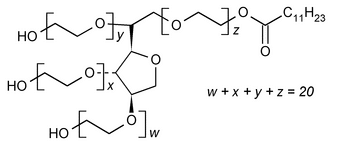Polysorbate 20
Sorbitan, monododecanoate, poly(oxy-1,2-ethanediyl) derivs.;
Polyoxyethylene 20 sorbitan monolaurate

 [9005-64-5].
[9005-64-5].
(pol'' ee sor' bate).
Sorbitan, monododecanoate, poly(oxy-1,2-ethanediyl) derivs.;
Polyoxyethylene 20 sorbitan monolaurate
DEFINITION
Polysorbate 20 is a laurate ester of sorbitol and its anhydrides copolymerized with approximately 20 moles of ethylene oxide for each mole of sorbitol and sorbitol anhydrides.
IDENTIFICATION
• A.
Sample solution:
1 in 20, in water
Analysis:
To 5 mL of the Sample solution add 5 mL of sodium hydroxide TS. Boil for a few min, cool, and acidify with 3 N hydrochloric acid.
Acceptance criteria:
The solution is strongly opalescent.
• B.
Sample solution:
1 in 20, in water
Analysis:
To 2 mL of the Sample solution add 0.5 mL of bromine TS, dropwise.
Acceptance criteria:
The bromine is not decolorized (distinction from polysorbate 80).
IMPURITIES
• Residue on Ignition  281
281 :
NMT 0.25%
:
NMT 0.25%
• Heavy Metals, Method II  231
231 :
NMT 10 ppm
:
NMT 10 ppm
SPECIFIC TESTS
• Acid Value
Sample:
10.0 of Polysorbate 20
Analysis:
Transfer the Sample to a wide-mouth, 250-mL conical flask, and add 50 mL of neutralized alcohol. Heat on a steam bath nearly to boiling, shaking thoroughly occasionally while heating. Invert a beaker over the mouth of the flask, cool under running water, and add 5 drops of phenolphthalein TS. Titrate with 0.1 N sodium hydroxide VS.
Acceptance criteria:
NMT 4 mL of 0.1 N sodium hydroxide, corresponding to an acid value of 2.2
• Fats and Fixed Oils, Hydroxyl Value  401
401 :
96–108
:
96–108
• Water Determination, Method I  921
921 :
NMT 3.0%
:
NMT 3.0%
ADDITIONAL REQUIREMENTS
• Packaging and Storage:
Preserve in tight containers.
Auxiliary Information—
Please check for your question in the FAQs before contacting USP.
| Topic/Question | Contact | Expert Committee |
|---|---|---|
| Monograph | Robert H. Lafaver, M.S.
Scientific Liaison 1-301-816-8335 |
(EXC2010) Monographs - Excipients |
USP35–NF30 Page 1919
Pharmacopeial Forum: Volume No. 37(4)
